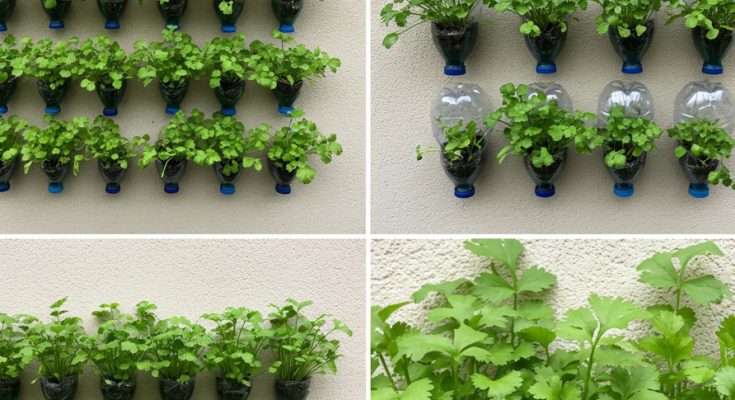Creating a plastic bottle wall planter is a simple and eco-friendly project that saves space while ensuring you have a steady supply of fresh cilantro at your fingertips. This method is perfect for balconies, patios, sunny kitchens, or even outdoor walls, making it ideal for both experienced gardeners and beginners.
Why Choose a Wall Planter for Cilantro?
Cilantro grows quickly and benefits from cool, well-drained conditions. A vertical bottle planter helps meet these needs by:
-
-
Maximizing Space – Ideal for small areas where traditional pots may not fit.
-
Improving Airflow – Helps reduce the risk of fungal diseases.
-
Easy Access – Herbs are within reach for cooking.
-
-
Sustainability – Reuses plastic bottles, reducing waste.
Additionally, a wall planter keeps cilantro off the ground, minimizing the chance of pests like snails or slugs damaging the leaves.
Choosing and Preparing Plastic Bottles
Select sturdy bottles—1.5-liter or 2-liter soda bottles are ideal, offering enough space for cilantro’s shallow but spreading roots. Avoid bottles that are cracked or weakened, as they need to support soil and plants over time.
Preparation steps:
-
-
Wash the Bottles – Remove labels, wash with soapy water, rinse thoroughly, and let them dry.
-
Cut Planting Openings – Lay the bottle horizontally and cut an oval or rectangular window in the side. This will be where your cilantro grows.
-
-
Make Drainage Holes – Poke small holes in the bottom to prevent excess water from accumulating.
-
Optional Finishing Touches – Paint or wrap the bottles in decorative material to protect roots from sunlight and enhance appearance.
Setting Up the Wall Planter
There are several ways to arrange the bottles:
-
-
Mounted on a Wooden Frame – Bottles are secured in rows with nails, screws, or cable ties.
-
Hanging with Rope or Wire – Each bottle is suspended individually.
-
-
Fixed to a Fence or Wall – Bottles are attached directly to a solid surface.
Regardless of the setup, position the planter in a location where it will get at least 4–6 hours of direct or bright filtered sunlight daily. Cilantro prefers cooler temperatures, so in hot climates, choose a spot with some afternoon shade.
Soil and Planting Cilantro
Cilantro grows best in light, well-draining soil. For bottle planters, use a mix that retains some moisture but doesn’t become waterlogged.
Recommended mix:
-
-
2 parts potting soil
-
1 part compost
-
-
1 part coarse sand or perlite
You can plant cilantro from seeds or transplants:
From Seeds
-
-
Sow seeds directly into the prepared bottle, about 1–2 cm deep.
-
-
Plant several seeds in each bottle, as germination can be uneven.
-
Keep the soil moist until sprouts appear, usually within 7–10 days.
From Transplants
-
-
Gently remove the plant from its pot and place it in the bottle opening.
-
Fill around the roots with soil and press lightly.
-
Watering and Sunlight Care
Cilantro needs consistent moisture but should never sit in soggy soil. In a bottle planter, water thoroughly until excess drips from the drainage holes, then allow the top layer to dry slightly before watering again.
Since bottle planters can dry out faster than ground soil, check moisture levels regularly, especially in warm weather.
As for light, cilantro thrives in cooler seasons with full sun but may bolt quickly in extreme heat. In hot climates, partial shade in the afternoon can extend its growing period.
Feeding and Maintenance
Feed cilantro with a diluted liquid fertilizer or compost tea every 2–3 weeks to encourage healthy leaf growth. Avoid over-fertilizing, which can cause the plant to focus on stems rather than leaves.
Harvest leaves frequently to promote continuous growth. Snip outer leaves first, allowing the inner stems to keep producing. If the plant begins to flower, remove the blooms promptly to slow bolting, unless you want to collect seeds.
Pest and Disease Management
Cilantro is generally resistant to many pests, but aphids, whiteflies, and spider mites can sometimes appear. To manage them naturally:
-
-
Spray with a mild soap solution.
-
Use a strong stream of water to dislodge pests.
-
Ensure good airflow between bottles.
-
Prevent fungal diseases by avoiding overhead watering and allowing soil to dry slightly between watering sessions.
Harvesting Cilantro
Once the plants reach 10–15 cm in height, you can begin harvesting. Cut stems just above a leaf node to encourage regrowth. Fresh cilantro is best used immediately for flavor and aroma, but you can also store leaves in a sealed container in the refrigerator for a few days.
If plants start to bolt and produce seeds, let some mature. The seeds, known as coriander, can be harvested for cooking or saved for the next planting cycle.
Final Thoughts
Making a plastic bottle wall planter for cilantro is a creative and sustainable way to enjoy this flavorful herb year-round. It’s an excellent option for urban gardeners, balcony growers, and anyone who wants fresh herbs without taking up much space. By using recycled materials, you’re reducing waste while creating a living wall that adds greenery and fragrance to your home.
With the right setup, good soil, and proper care, your vertical cilantro garden will thrive—offering a steady harvest for all your culinary needs.
